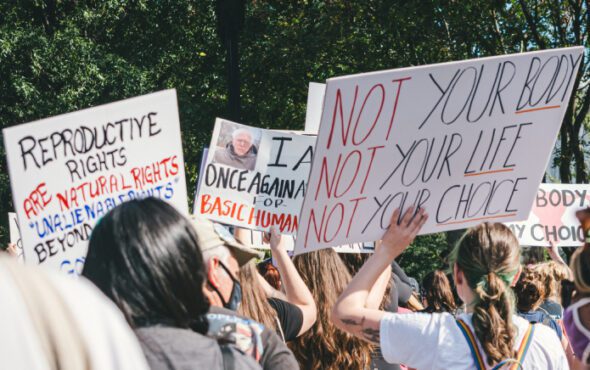
It was getting an abortion after being raped as a teenager that drove transgender man Adri Perez to help set up an LGBTQ-inclusive fund in the U.S. state of Texas to support others wanting to end their pregnancies.
The Supreme Court’s reversal of the 1973 Roe v. Wade ruling that legalised abortion in the United States has spotlighted global inequalities in access to the procedure, including for trans men, who face challenges from gendered abortion laws to economic marginalisation and discrimination.
For Perez, co-founder of the Texas-based West Fund – which has paused its operations following the June 24 ruling – the fight for trans rights and abortion access have much in common.
“Trans justice and reproductive justice are linked together by the fact that what they are both fighting for at their core is bodily autonomy,” said 29-year-old Perez, who uses they/them pronouns and was not openly trans at the time of their abortion.
Trans men and non-binary people, who define themselves as neither male or female, are among those who may need abortions, as they may have a uterus and ovaries.
Taking testosterone significantly reduces the likelihood of pregnancy, but does not eliminate it completely, scientists say.
But trans and non-binary people can struggle with access to reproductive care, from gendered laws that lock them out, through to financial barriers and sabotage by family members, say campaigners and experts.
Meanwhile, the use of inclusive language like ‘pregnant people’ has been criticised by some feminists who say it erases women.
Trans campaigners say the debate threatens to needlessly pit women and trans people against each other and reduce their access to services.
Cazembe Murphy Jackson, a 42-year-old trans man, has spoken out about his own experience of pregnancy and abortion as a result of a rape in college in an effort to improve services.
He said the mental health impacts of getting an abortion or being forced to carry a pregnancy to term are magnified for trans men and can be deadly, as the changes to their body can increase stress over the mismatch with their gender identity.
“Some people try and do (self-managed) abortions that are not safe,” he said.
BARRIERS TO CARE
Half of U.S. states are expected to ban all or most abortions following the overturning of Roe v. Wade, according to reproductive rights organisation the Guttmacher Institute.
People in these areas will now have to travel for abortions elsewhere.
That creates a particular barrier for marginalised groups such as trans people, said activists, with many struggling to afford extra time and travel costs to reach clinics.
Trans people in the U.S. are disproportionately likely to be poor, acording to a 2019 study by the Williams Institute at the UCLA School of Law, and about a third live in southern states, many of which have very restrictive abortion policies.
Many of those in work may be unable to seek support and financial aid from their employer as they have not disclosed the fact they are trans and fear discrimination, said Jackson.
Some American trans and non-binary people attempt home abortions for reasons including a lack of health insurance, legal restrictions, denials of care or mistreatment, and cost, according to a 2021 study in the BMJ Sexual & Reproductive Health journal.
A push to make abortion services more inclusive to trans and non-binary people by replacing gendered language such as ‘woman’ or ‘mother’ with alternatives like ‘pregnant person’ has led to heated criticism from some women.
On July 4, actor Bette Midler made headlines after she tweeted about the terms ‘birthing people’ and ‘menstruators’. Directing her message at “women of the world”, she wrote: “Don’t let them erase you! Every human on earth owes you!”
LGBTQ+ groups say that making it clear that services are open to all helps gender minorities get equal access to care.
“Trans people exist. Even if you leave us out of the conversation, we’re still here,” Jackson said.
LEGAL BLOCKS
Gendered language in legislation has blocked access to abortion for some trans men.
In Bolivia, laws giving restricted rights to abortion refer only to women.
Trans men who have updated their documents to match their gender identity have sometimes been denied access to terminations, found LGBTQ+ organisation Manodiversa in a report.
In some cases, trans men were barred from leaving the house to get an abortion by family members who believed that if they gave birth they would become “real women”, the group said.
In Ireland, abortion during the first 12 weeks of pregnancy was legalised in 2018, but the law only refers to ‘women’, something LGBTQ+ groups unsuccessfully campaigned to change.
Campaigners had warned that language could result in trans men being denied access to abortion.
LGBTQ+ rights group ILGA-Europe could not comment on whether trans men were being turned away in practice, but said the law risks discrimination.
“Being turned away is usually not just about the law, it’s about the opinions of the medical providers, or even front desk staff,” said Cianan Russell, a senior policy officer.
“People will get turned away when they call to ask for an appointment because their voice sounds male, they will be told ‘We don’t serve people like you.'”
The Philippines bars trans men from changing gender or having hysterectomies that would remove their ability to carry children, said Nil Nodalo, founder of TransMan Pilipinas.
The country also has a near-total ban on abortions, with some of the heaviest restrictions in the world.
The Philippines Department for Health did not respond to requests for comment.
Some people try to induce home abortions with methods including being kicked, or taking pills bought online, said Clara Rita Padilla, a lawyer and the director of women’s rights organisation EnGendeRights.
“I have come across lesbian and transgender men who just carry their pregnancies to term,” she added.
Reporting by Lucy Middleton; Editing by Sonia Elks.
GAY TIMES and Openly/Thomson Reuters Foundation are working together to deliver leading LGBTQ+ news to a global audience.



